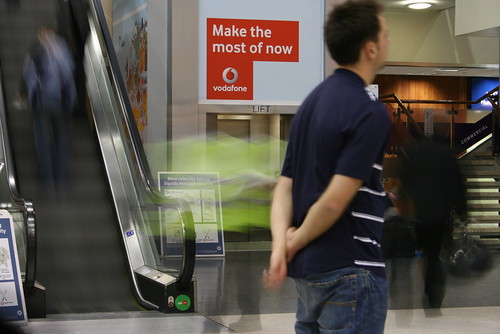
(image source: Vabellon)
Clearly, the mobile phone is used to ‘optimize time’ – at least, this idea of “making the most of NOW” is one of the strong rhetorics about mobile media: to do something useful with in-between moments that is ‘lost time’ otherwise.
Increasingly, is seems mobile media are being deployed to optimize spatial mobility too. This fits perfectly in the current trend of producers and operators moving towards ‘location-based services’. Just a few examples upon which I stumbled in the last days.
First, Dutch car navigation company TomTom has won the “Van AnaarBeter” prize (in Dutch) for their service products HD Traffic and IQ-routes. The prize is awarded by the Ministry of Traffic and Waterworks to stimulate innovation that help solve traffic congestion and physical mobility issues. The prize was handed to TomTom by Dutch minister Camiel Eurlings.
Second, the New York Times has an article about two new services for the iPhone that help coordinate car pooling. One is called Avego, an iPhone application intended to let drivers and prospective passengers connect and share rides. Avego charges 30 cents ($) a mile, says Irish director of Avego, of which 85 percent goes to the driver 15 percent to the company. All payments will be handled by automated online accounting. Another service mentioned in the article is USA-based company Carticipate. In Holland car pooling never really took off. And according to the NYT article in the USA number dwindled from 20% in 1980 to 10% in 2007.
Will these new applications make “carpooling 2.0” more attractive? Can they help in creating peer-to-peer solutions to congestion and mobility problems? And perhaps even be a new way of meeting strangers – one of the pillars of urban culture – through our mobility patterns instead of being based on ‘fixed’ physical locations? Or are we already too ‘capsularized‘ to be able to stand strangers in our cars?
John Urry uses the term “mobility system” (in ‘Mobilities‘ 2007) to describe the complex set of technologies, infrastructures, and social factors that enable mobility as “predictable and relatively risk-free repetition”. For instance the automobile system is much more than just cars. It relies on the mining and logistics of fuel, creating new roads, needs a (near universal) sign language, education and exams for licensing, maps, public trust in other drivers, etc.
It is interesting to see how physical mobility systems themselves are becoming more and more ‘hybrid’ too, that is, infused with software systems. The car mobility system and the mobile phone system merge. And not only through institutional top-down software sorting systems, e.g. highway traffic monitoring systems and toll road access accounting, but increasingly through peer-to-peer mobile technologies like the ones mentioned here.
